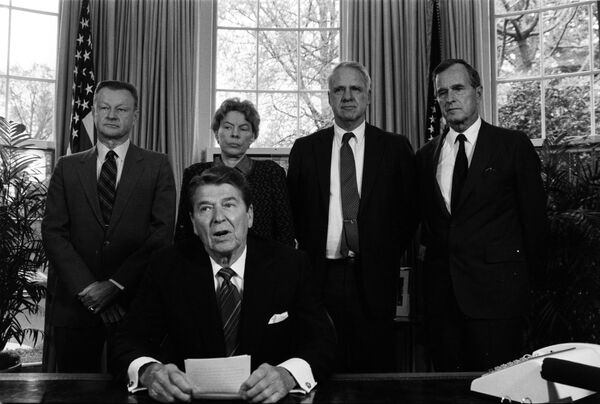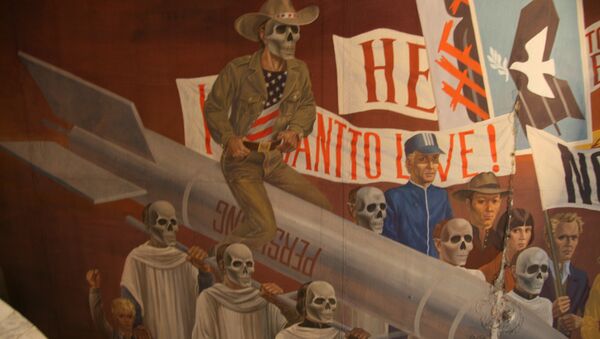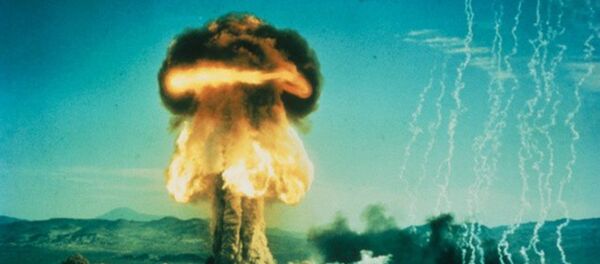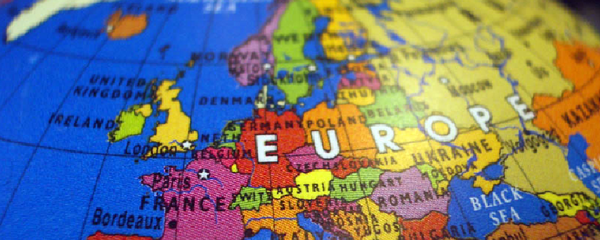NATO seeks Russia's destabilization hoping to slice it up, Gary Leupp, a Professor of History at Tufts University states, questioning whether it is actually the Alliance which poses the real threat to the world.
"The North Atlantic Treaty Organization was formed in April 4, 1949, initially consisting of the US, Canada, UK, France, Italy, the Netherlands, Belgium, Luxembourg, Denmark, Iceland, Norway and Portugal, as a military alliance against the Soviet Union, and principally the Russian Soviet Federative Socialist Republic," Professor Leupp narrates in his article for Counterpunch.com.
He emphasizes that the Soviet Union "had contributed disproportionately" to the defeat of Nazism: the Second World War claimed the lives of eight million Soviet military servicemen and 12 million civilians. For comparison's sake the United States casualties amounted to around 186,000 in the European theatre and 106,000 in the Pacific.
However, Washington rushed to establish an alliance aimed against its wartime ally, the USSR.
The US and Britain expressed their concerns about the "geopolitical advances" of the Soviet Union, exhausted and devastated during the WWII.
"British Prime Minister Churchill while visiting the US [in 1946] alluded to an 'iron curtain' falling across Europe," the professor notes, adding sarcastically that the same expression was used just thirteen months earlier by infamous Nazi minister of propaganda Joseph Goebbels.
NATO continued its expansion, joining Greece and Turkey in 1952 and the Federal Republic of Germany in 1955. And only then, in 1956 the USSR formed the Warsaw Treaty Organization bringing together eight nations (to NATO's 15): the USSR, Bulgaria, Czechoslovakia, East Germany, Hungary, Poland, Romania and Albania.
Interestingly enough, the Warsaw Treaty Organization by no means could boast the military activity comparable to that of NATO.
"Between 1945 and 1991 (when the Warsaw Pact and the USSR both dissolved themselves), the US had engaged in three major wars (in Korea, Vietnam, and the Persian Gulf); invaded Grenada and Panama; and intervened militarily in Guatemala, the Dominican Republic, Lebanon, Cuba, Cambodia, Laos, Nicaragua, Haiti and other countries," the American academic underscores.
Jimmy Carter's National Security Adviser Zbigniew Brzezinski urged then US president to help the Afghani Mujahedeen ("those engaged in jihad") to oust Mohammad Najibullah and make the Soviets "bleed."
"The anti-Soviet jihadis were welcomed to the White House by President Ronald Reagan during a visit in 1985. Reagan, perhaps already showing the signs of Alzheimer's disease, trumpeted them as 'the moral equivalent of America's founding fathers'," the professor continues.
However, jihadists' highly praised moral sense had not prevented them from dragging Afghanistan into an abyss of endless bloodbath, and killing Najibullah with an exceptional brutality.

After the collapse of the Soviet Union in 1991 and dismantling of the Warsaw Pact, NATO continued to grow, absorbing former Soviet satellites. The Alliance was steadily expanding its sphere of influence creeping up to Russia's borders.
Leupp quotes George Kennan, the famous US diplomat, who said in a response to Poland, Hungary and Czechoslovakia's joining NATO in 1998:
"I think it is a tragic mistake. There was no reason for this whatsoever… It shows so little understanding of Russian history and Soviet history. Of course there is going to be a bad reaction from Russia, and then [the NATO expansion advocates] will say that we always told you that is how the Russians are — but this is just wrong."
The post-Cold War period has been marked by serious geopolitical tensions, Western unilateral invasions, color revolutions and civil wars, in contrast to Cold War — a period of relative stability in the world.
The irony of the situation is that it was Russia, not NATO who has been ultimately labeled as an "existential threat" to peace.
"These are wild, stupid words coming from highly placed figures. Isn't it obvious that Russia is the one being surrounded, pressured and threatened? That its military budget is a fraction of the US's, its global military presence miniscule in relation to the US footprint?" the professor points out.
It is begging the question why the US and NATO persist in encircling Russia.
"What do you do after you complete the Western encirclement of Russia?" the American academic asks and adds: "Why, you destabilize the country itself, hoping to slice it up!"
It is all about partitioning Russia, a vast territory rich with natural resources.
"If Russia is an existential threat, its own existence is a threat, right? So why not cut it up?" Leupp continues, posing yet another question, whether NATO itself is the real threat to the world's peace and stability.
"Shouldn't we welcome resistance to further expansion, complaints about US arm-twisting, and calls for cooperation with Russia rather than confrontation and destruction?" the American professor asks.




